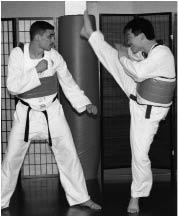Complete Kicking (32 page)
Authors: Turtle Press

TRAINING TIP: To succeed with techniques like this involving diagonal movements, you have to outplay your opponent with agile footwork.
HOP DOUBLE ROUNDHOUSE KICKS
how to
1. When your opponent retreats, hop in, bringing your rear foot forward to close the distance and simultaneously kick the closest target (thigh or ribs).
2. Before your kicking foot lands, throw a roundhouse kick to the lower abdomen with your other leg. The power in this combination comes from pivoting your full body weight around your first kicking leg while in the air.
TRAINING TIP: In double kicking, your legs work like a scissors. Use your body’s falling momentum to create maximum power in the second kick.
AXE KICK-ROUNDHOUSE KICK
how to
1. Throw a rear leg axe kick to the face and step down in front. When you attack with axe kick, the opponent has two options: retreat or retaliate.
2. If he retreats, follow up with a powerful rear leg middle section roundhouse kick to his abdomen.
TRAINING TIP: If your opponent doesn’t retreat and instead counters with his rear leg, block it with your forearm and punch to the chest to make space between you. Then follow up with a rear leg roundhouse kick to the trunk or face.
ROUNDHOUSE KICK-JUMP SPIN WHIP KICK
how to
1. Throw a powerful rear leg roundhouse kick to the stomach and step down in front. Generally an opponent will crouch in pain or stand up suddenly to expand his ribs and try to catch his breath.
2. If he stands up tall to breathe, jump and throw a rear leg spinning whip kick to the head.
TRAINING TIP: If your opponent bends forward after your first kick, throw a roundhouse kick to the face or neck with the same leg.
TRIPLE ROUNDHOUSE KICKS
how to
1. Execute all three kicks in one breath. First, counterattack with rear leg roundhouse kick against rear leg roundhouse kick. Step down at a 45° angle to the opponent.
2. As the opponent’s foot lands and he inhales, throw a roundhouse kick to his rib cage with your other leg.
3. Before setting your kicking leg down, launch a roundhouse kick to the solar plexus with your standing leg (hopping double roundhouse kick).
TRAINING TIP: The purpose of the first kick is to penetrate your opponent’s defense and make him move backwards or go on defense. The second and third kicks should be done before he can recover and counterattack.
RULE OF ELIMINATION:
A lack of balance in your combination kicks indicates two possible problems: something is disrupting your gravitational center or your base is weak.
Solutions: Eliminate bad habits and make minute changes to establish better habits.
Try the following exercises:
1. From a squat, jump up, turn around and land in the same position in one motion.
2. Draw a straight line on the floor and practice combination kicking moving along the line to enhance your sense of your center of gravity.
3. Practice the combination in extreme slow motion, holding each kick extended for 30 seconds or until you lose your balance. When you lose balance, move on to the next kick in the combination. Notice how your standing leg and your posture affect your kicks
4. To focus on improving your transitions between kicks, practice the combination using only kick chambers instead of full kicks. For each kick, quickly raise your knee to the chamber position and then step down and quickly proceed to the next movement in the combination.
PUTTING IT ALL TOGETHER:
1. Keep your head upright.
2. Look at the target from start to finish.
3. Check your body alignment.
4. Practice a variety of stances for different techniques.
5. Pay attention to details while you are moving to eliminate unnecessary motions that hinder performance.
6. Keep your knees relaxed and flexed— don’t lock them out.
7. Stay relaxed to conserve energy.
Other books
Highland Hawk: Highland Brides #7 by Greiman, Lois
The Courbet Connection (Book 5) (Genevieve Lenard) by Estelle Ryan
Something in the Blood (A Honey Driver Murder Mystery) by Goodhind, Jean G
Ariel by Donna McDonald
Swept Up by Holly Jacobs
A Dark and Broken Heart by Ellory, R.J.
Saved by the SEAL by Diana Gardin
The Defectors (Defectors Trilogy) by Benner, Tarah
MacAlister's Hope by Laurin Wittig
Nine White Horses by Judith Tarr








